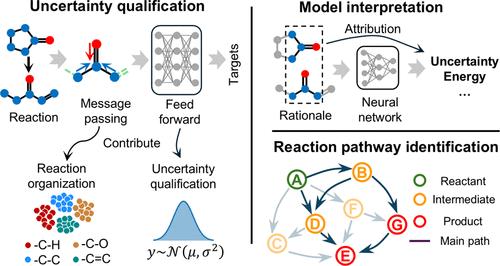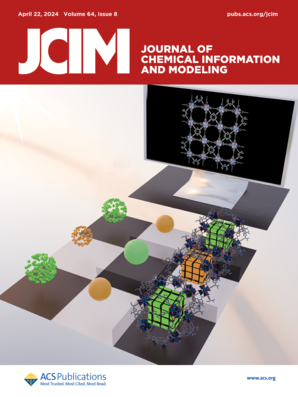基于深度学习的基本反应特性预测的不确定性鉴定
IF 5.6
2区 化学
Q1 CHEMISTRY, MEDICINAL
引用次数: 0
摘要
由于采用了深度学习(DL)方法,对基本反应的热力学和动力学性质的预测得到了迅速改善。虽然已有多项研究成功预测了反应特性,但对预测不确定性的量化却鲜有研究,从而影响了在实际应用中使用这些预测特性的信心。在此,我们将图卷积神经网络(GCNN)与三种不确定性预测技术(包括深度集合、蒙特卡罗(MC)-剔除和证据学习)进行了整合,以深入了解不确定性量化和实用性。在所有基本反应特性数据集中,深度集合模型的准确性优于其他模型,并且在估计预测不确定性方面表现出最高的可靠性。我们还验证了深度集合模型在识别认识不确定性和估计不确定性方面表现出令人满意的能力。此外,我们采用蒙特卡洛树搜索法提取了可解释的反应子结构,为 DL 预测性质和相应的不确定性提供了化学解释。最后,为了证明不确定性鉴定在实际应用中的实用性,我们对 DL 构建的动力学模型进行了不确定性指导校准,与没有不确定性指导的校准相比,在识别主要反应途径方面的命中率提高了 25%。本文章由计算机程序翻译,如有差异,请以英文原文为准。

Uncertainty Qualification for Deep Learning-Based Elementary Reaction Property Prediction
The prediction of the thermodynamic and kinetic properties of elementary reactions has shown rapid improvement due to the implementation of deep learning (DL) methods. While various studies have reported the success in predicting reaction properties, the quantification of prediction uncertainty has seldom been investigated, thus compromising the confidence in using these predicted properties in practical applications. Here, we integrated graph convolutional neural networks (GCNN) with three uncertainty prediction techniques, including deep ensemble, Monte Carlo (MC)-dropout, and evidential learning, to provide insights into the uncertainty quantification and utility. The deep ensemble model outperforms others in accuracy and shows the highest reliability in estimating prediction uncertainty across all elementary reaction property data sets. We also verified that the deep ensemble model showed a satisfactory capability in recognizing epistemic and aleatoric uncertainties. Additionally, we adopted a Monte Carlo Tree Search method for extracting the explainable reaction substructures, providing a chemical explanation for DL predicted properties and corresponding uncertainties. Finally, to demonstrate the utility of uncertainty qualification in practical applications, we performed an uncertainty-guided calibration of the DL-constructed kinetic model, which achieved a 25% higher hit ratio in identifying dominant reaction pathways compared to that of the calibration without uncertainty guidance.
求助全文
通过发布文献求助,成功后即可免费获取论文全文。
去求助
来源期刊
CiteScore
9.80
自引率
10.70%
发文量
529
审稿时长
1.4 months
期刊介绍:
The Journal of Chemical Information and Modeling publishes papers reporting new methodology and/or important applications in the fields of chemical informatics and molecular modeling. Specific topics include the representation and computer-based searching of chemical databases, molecular modeling, computer-aided molecular design of new materials, catalysts, or ligands, development of new computational methods or efficient algorithms for chemical software, and biopharmaceutical chemistry including analyses of biological activity and other issues related to drug discovery.
Astute chemists, computer scientists, and information specialists look to this monthly’s insightful research studies, programming innovations, and software reviews to keep current with advances in this integral, multidisciplinary field.
As a subscriber you’ll stay abreast of database search systems, use of graph theory in chemical problems, substructure search systems, pattern recognition and clustering, analysis of chemical and physical data, molecular modeling, graphics and natural language interfaces, bibliometric and citation analysis, and synthesis design and reactions databases.

 求助内容:
求助内容: 应助结果提醒方式:
应助结果提醒方式:


